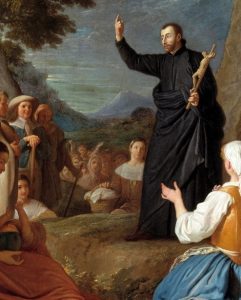 Saint John Francis Regis
Saint John Francis Regis
Jesuit missionary (1597-1640)
Feast – June 16
“For our struggle is not with flesh and blood but with the principalities, with the powers, with the world rulers of this present darkness, with the evil spirits in the high places.” (Ephesians 6, 12)
Our enemy, the devil, knows that he can cause the most damage by influencing people in positions of power and authority. The Church and government are his first targets. In 1517 Martin Luther (an Augustinian monk and university lecturer in Wittenberg) sponsored by local German rulers, who were seeking annexation of Catholic Church property, started the Protestant Reformation. Similarly in France a significant number of provincial aristocrats seeking to enlarge their influence and take control of the country, and with them thousands of their subjects, left the Catholic Church, rejected Her teachings, and became followers of the French theologian, pastor and reformer John Calvin, a principal figure in the development of the system of theology later called Calvinism. This system is based on the doctrine of predestination which holds that God works through the Holy Spirit to bring about the salvation of an individual through spiritual regeneration, regardless of the individual’s cooperation. French Calvinists adopted the name Huguenot, some say, after Hugues Capet, king of the Franks from 987 to 996, who through crafty political maneuvers worked his way to the throne.
In 1560 the Huguenots under the leadership of Godefroy de Barry, seigneur de La Renaudie, with the support of many aristocrats among them the Admiral of France Gaspard de Coligny, decided to take power over France by abducting the young king Francis II and arresting Francis, Duke of Guise and his brother, the Cardinal of Lorraine. The Amboise conspiracy, also called the Tumult of Amboise failed and became the event directly leading up to the Wars of Religion from 1562 to 1598, after which in 1593 king Henry IV officially converted to Catholicism and in April 1598 signed the Edict of Nantes establishing France as essentially a Catholic country.
The wars were over but the consequences of the Huguenots’ failed power grab, especially in southern France where they destroyed Catholic churches and murdered the priests, had not faded. Hundreds of thousands of confused citizens of the first daughter of the Church had to be brought back home.
St. John Francis Regis was one of those whom God called to fulfill this task.
He was born on the 31st of January, in 1597, at Foncouverte (department of Aude), a village in the diocese of Narbonne in Languedoc southern France, of a noble Catholic family. His father, Jean Régis, had recently been ennobled as a result of service rendered during the Wars of the Holy League. His mother, Marguerite de Cugunhan, was of a noble family. They were distinguished amongst the nobility of Lower Languedoc by their virtue. Their eldest son was killed in the siege of Villemur, in a rally made by the Huguenot garrison. St. Francis was the youngest one. From his tenderest years he showed evidence of uncommon sanctity by his innocence of life, modesty, and love of prayer. At five years of age, he fainted away while hearing his mother speak of the horrible misfortune of being eternally damned, which left a lasting impression on his tender heart.
His parents watched with Christian solicitude over the early education of their son.
When he reached the age of fourteen, he was sent to continue his studies in the newly opened Jesuit college at Beziers. His conduct there was exemplary. Avaricious of his time, he scarcely allowed himself any for necessary relaxation. Sundays and holidays were a most precious time to him, and he divided them entirely between pious reading and devotions at home and in the church. He was often seen on those days retired in a chapel and bathed in tears in the presence of Jesus Christ. His good humor, frankness, and eagerness to oblige everybody soon won for him the good-will of his comrades. But St. John did not love the world, and even during the vacations lived in retirement, occupied in study and prayer.
At the end of his five years’ study of the humanities, grace and his ascetic inclinations led him to embrace the religious life under the standard of St. Ignatius Loyola.
On 8 December 1616, in his nineteenth year, with the approbation of confessor, he entered the Jesuit novitiate at Toulouse. After two years of probation, he made his religious vows in 1618, and was then sent to Cahors. After finishing his course in rhetoric at Cahors, St. John was sent to teach grammar at several colleges: Billom (1619–22), Puy-en-Velay (1625–27), and Auch (1627–28). He followed the traditional Jesuit path of teaching and studying, while teaching, he studied philosophy at the scholasticate at Tournon. Despite his rigorous academic schedule, he spent many hours in chapel, and viewed as a model of every virtue was called the Angel of the College.
During this time, he made his first attempts as a preacher. On feast-days he loved to visit the towns and villages of the neighborhood, and there give an informal instruction, which never failed–as attested by those who heard him–to produce a profound impression on those present.
As he burned with the desire to devote himself entirely to the salvation of his neighbor, he aspired with all his heart to the priesthood. In this spirit he began in October 1628, his theological studies at Toulouse. The four years he was supposed to devote to them seemed to him so very long that he finally begged his superiors to shorten the term. This request was granted, and in consequence St. John said his first Mass on Trinity Sunday, June 15, 1631. His first assignment was teaching at the Jesuit school at Pamiers to supply the place of a master who had fallen sick. After pleading successfully to his superiors, he spent the rest of that year caring for victims of a plague outbreak in Toulouse.
From May 1632 his headquarters was at the Jesuit College of Montpellier. In 1633, he went to the Diocese of Viviers at the invitation of the bishop, Louis-François de la Baume de Suze.
Here he labored for the conversion of the Huguenots. While the formal sermons of the day tended toward the poetic, his discourses were plain, inflamed with the love of God and filled with fervor which attracted people of all classes. His own example: visiting the hospitals, assisting the needy, withdrawing wayward girls and women from vice, and holy ascetic life made them even more powerful. During two years as a home missioner there, he had outstanding results. He succeeded in converting many people and in bringing many others back to religious observances. His Superiors decided to assign their young Saint to the mission lands of France. He took up the pattern of constant travel that marked the rest of his brief life. He walked from town to town, in rough mountainous area where travel was difficult, especially in the winter. He would remain in a parish several days giving sermons that were simple but sincere and flowed from a heart close to God. A witness at his beatification testified that St. John often preached outdoors all day, then heard confessions throughout the night then celebrated Mass and catechized in the morning.
St. John especially made himself available to the poor. He established safe houses for at-risk women and orphans and found jobs for them. Established the Confraternity of the Blessed Sacrament, which organized charitable collections of money and food from the wealthy. He also established several hostels for prostitutes, and helped many become trained lace makers, which provided them with a stable income and an opportunity to avoid the threat of exploitation. He established an association of women to procure aid for prisoners. Soon he earned a reputation as a saint.
The winters he spent in the missions of the mountainous districts, where the people were seen to travel long miles on foot through the snows and across ice, to hear the servant of God and make their confessions. Many of them accompanied him on his journeys from one place to another, leaving all things to hear him. During the summer he preached in Le Puy, which soon changed its aspect by his catechisms. Up to five thousand listeners crowded in to hear him at the church of the Benedictines of Saint-Pierre-le-Moustiers. From 1633 to 1640 he evangelized more than fifty districts in le Vivarais, le Forez, and le Velay.
His work led to many conversions, but not everyone appreciated the transports of his zeal, which some perceived as arrogance, impetuous and meddlesome, some jealous priests accused him of preaching not evangelical sermons, and troubling the peace of families by an indiscreet charity. This created a period of tension with the local bishop, and even threats.
Patience, humility, the reputation of the sanctity following our saint succeeded in confounding the calumny and caused the discreet and enlightened ardor of his life to shine forth with renewed splendor.
Numerous miracles happened through his intercession. In 1635 in Marlhes a boy had fallen from the top of a high pair of stairs to the bottom near the holy man, then after his prayer in a corner, was found without injury.
A woman who mended his tapered cloak, kept two rags as relics and by applying them to two of her children, cured one of a fever and the other of formed dropsy.
Under the intercession of St. John in times of need God miraculously multiplied the corn on several occasions. Several cures occurred on the spot by his prayers.
The Curé of Ars obtained a famous miracle with a medal of our Saint. The orphanage of Ars had no more grain for bread, and the harvest had been so scanty the people could not be asked for any more aid. The Curé of Ars put a medal of Saint John Francis behind the door of the empty storeroom, and the next day they could scarcely open that door, so full had the room become overnight.
In 1636 Claudius Sourdon, the fourteen year old son of Hugh Sourdon who was hosting St. John at the time, had been entirely deprived of all sight for the past six months, and after the saint’s prayer recovered his sight. Another man forty years of age who had been blind for eight years, was brought to the saint, and after making the sign of the cross over him, was healed immediately.
In November of 1637 the Saint set out for his second mission at Marthes in the mountains. His road lay across valleys filled with snow and over frozen and precipitous peaks. In climbing one of the highest, a bush to which he was clinging gave way, and he broke his leg in the fall; nonetheless, with the help of his companion and a staff, he managed to continue his journey for the remaining six miles. Then, instead of seeing a surgeon, he insisted on being taken straight to the confessional. After several hours, the parish priest found him still seated, and when his leg was finally examined the fracture was found to be miraculously healed.
A young man enraged that the saint had converted and drawn from him the object of his impure passion, resolved to kill him. The man of God discovered by a divine light his wicked intention, and said to him: “Dear brother, why do you bear this ill-will to one that would hazard his life to procure you the greatest of blessings, eternal salvation?” The sinner, overcome by his sweetness, fell at his feet, begged his pardon, and became a sincere convert. These are only a few examples of many miracles assigned to our saint.
In mid-December 1640 St. John and his companion, Brother Claude Bideau, went to Montregard. After finishing the mission there, on December 23rd the two set out for Lalouvesc, the site of the next mission, but a winter storm blew in and they lost their way in the snow and had to spend the night in a battered shack. The next day they were able to reach Lalouvesc where they found people waiting for them. Rather than taking a few minutes to eat and rest, Regis immediately began preaching, then heard confessions and celebrated Mass. So many people came for confession that Regis did not stop until it was time for Midnight Mass. Both Christmas day and the following day were also spent in the confessional. Because of the crush of people, by late afternoon he felt weak and suddenly collapsed. He was put in the pastor’s bed but people followed him even there, seeking to confess. He lapsed into unconsciousness, and the physician who attended him confirmed that pneumonia had set in. Nothing could be done. Regis lingered on until Dec. 31, praying constantly. His final words were: “Into thy hands I commend my spirit.”
St. John Francis Regis was beatified in 1716 by Pope Clement XI and canonized by Pope Clement XII in 1737. He is hailed as a confessor of the faith and a model for Jesuit missionaries. Although his feast day was established on June 16, the Jesuits celebrate St. John on July 2.
St. John’s tomb at La Louvesc became the site of many miracles. Was visited by Curé of Ars St. Jean-Baptiste Vianney in 1804 and remains to this day a popular site of pilgrimage.
References and Excerpts:
[1] F. Media, “Saint John Francis Regis | Franciscan Media.” https://www.franciscanmedia.org/saint-of-the-day/saint-john-francis-regis (accessed Jun. 04, 2021).
[2] C. Online, “St. John Francis Regis – Saints & Angels,” Catholic Online. https://www.catholic.org/saints/saint.php?saint_id=689 (accessed Jun. 04, 2021).
[3] “Saint John Francis Regis, Jesuit missionary.” https://sanctoral.com/en/saints/saint_john_francis_regis.html (accessed Jun. 04, 2021).
[4] “Saint John Francis Regis | The Society of Jesus.” https://www.jesuits.global/saint-blessed/saint-john-francis-regis/ (accessed Jun. 04, 2021).
[5] “CATHOLIC ENCYCLOPEDIA: St. John Francis Regis.” https://www.newadvent.org/cathen/08464a.htm (accessed Jun. 04, 2021).
[6] “Saint of the day: John Francis Regis | Angelus News,” Jun. 16, 2020. https://angelusnews.com/faith/saint-of-the-day/saint-of-the-day-john-francis-regis/ (accessed Jun. 04, 2021).
[7] “John Francis Regis,” Wikipedia. Jan. 31, 2021. Accessed: Jun. 04, 2021. [Online]. Available: https://en.wikipedia.org/w/index.php?title=John_Francis_Regis&oldid=1004035516
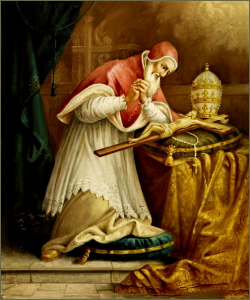 Saint Pius V
Saint Pius V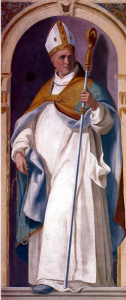 Saint Hugh
Saint Hugh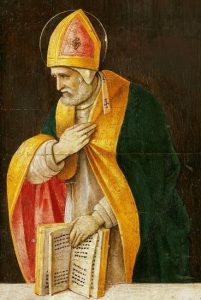 Saint Albinus
Saint Albinus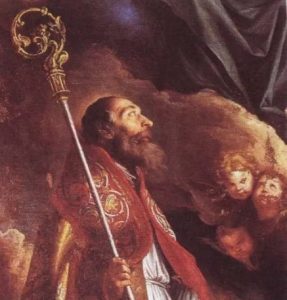 Saint Eucherius
Saint Eucherius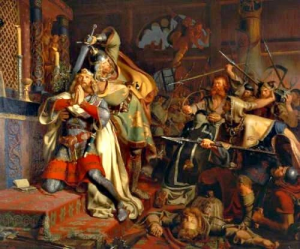 Saint Canute
Saint Canute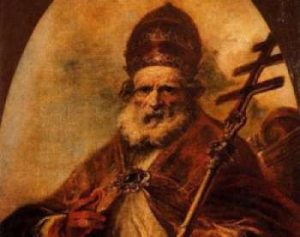 Saint Damasus
Saint Damasus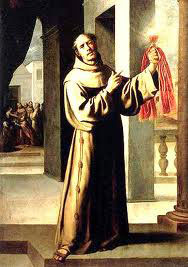 Saint James of The March of Ancona
Saint James of The March of Ancona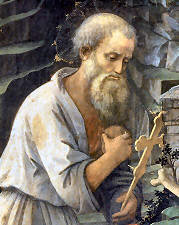 Saint Hilarion the Great
Saint Hilarion the Great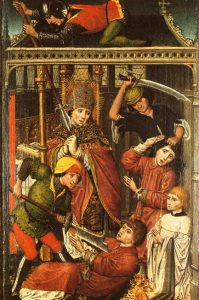 Saint Lambert
Saint Lambert